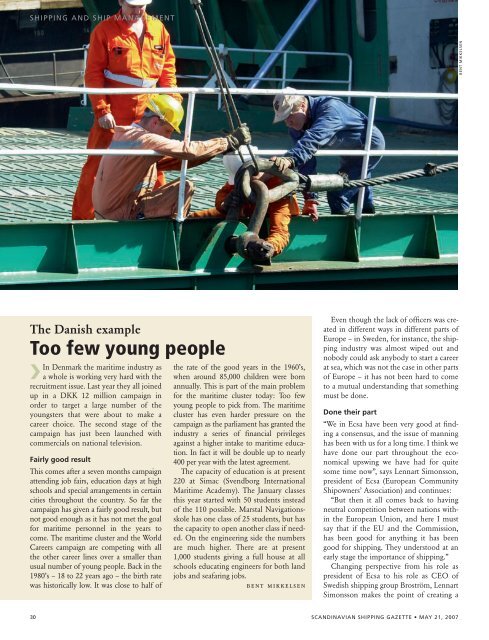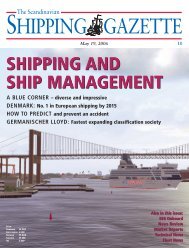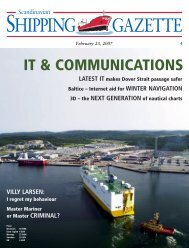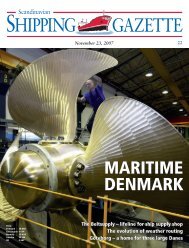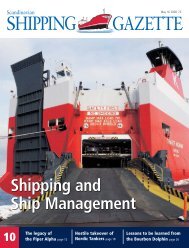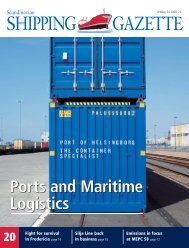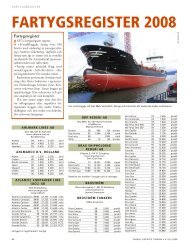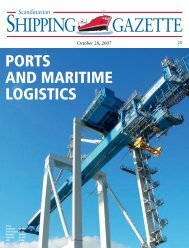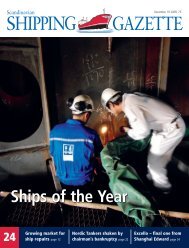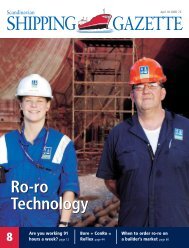SSG No 10 - Shipgaz
SSG No 10 - Shipgaz
SSG No 10 - Shipgaz
Create successful ePaper yourself
Turn your PDF publications into a flip-book with our unique Google optimized e-Paper software.
SHIPPING AND SHIP MANAGEMENT<br />
The Danish example<br />
Too few young people<br />
❯<br />
In Denmark the maritime industry as<br />
a whole is working very hard with the<br />
recruitment issue. Last year they all joined<br />
up in a DKK 12 million campaign in<br />
order to target a large number of the<br />
youngsters that were about to make a<br />
career choice. The second stage of the<br />
campaign has just been launched with<br />
commercials on national television.<br />
Fairly good result<br />
This comes after a seven months campaign<br />
attending job fairs, education days at high<br />
schools and special arrangements in certain<br />
cities throughout the country. So far the<br />
campaign has given a fairly good result, but<br />
not good enough as it has not met the goal<br />
for maritime personnel in the years to<br />
come. The maritime cluster and the World<br />
Careers campaign are competing with all<br />
the other career lines over a smaller than<br />
usual number of young people. Back in the<br />
1980’s – 18 to 22 years ago – the birth rate<br />
was historically low. It was close to half of<br />
the rate of the good years in the 1960’s,<br />
when around 85,000 children were born<br />
annually. This is part of the main problem<br />
for the maritime cluster today: Too few<br />
young people to pick from. The maritime<br />
cluster has even harder pressure on the<br />
campaign as the parliament has granted the<br />
industry a series of financial privileges<br />
against a higher intake to maritime education.<br />
In fact it will be double up to nearly<br />
400 per year with the latest agreement.<br />
The capacity of education is at present<br />
220 at Simac (Svendborg International<br />
Maritime Academy). The January classes<br />
this year started with 50 students instead<br />
of the 1<strong>10</strong> possible. Marstal Navigationsskole<br />
has one class of 25 students, but has<br />
the capacity to open another class if needed.<br />
On the engineering side the numbers<br />
are much higher. There are at present<br />
1,000 students giving a full house at all<br />
schools educating engineers for both land<br />
jobs and seafaring jobs.<br />
bent mikkelsen<br />
Even though the lack of officers was created<br />
in different ways in different parts of<br />
Europe – in Sweden, for instance, the shipping<br />
industry was almost wiped out and<br />
nobody could ask anybody to start a career<br />
at sea, which was not the case in other parts<br />
of Europe – it has not been hard to come<br />
to a mutual understanding that something<br />
must be done.<br />
Done their part<br />
“We in Ecsa have been very good at finding<br />
a consensus, and the issue of manning<br />
has been with us for a long time. I think we<br />
have done our part throughout the economical<br />
upswing we have had for quite<br />
some time now”, says Lennart Simonsson,<br />
president of Ecsa (European Community<br />
Shipowners’ Association) and continues:<br />
“But then it all comes back to having<br />
neutral competition between nations within<br />
the European Union, and here I must<br />
say that if the EU and the Commission,<br />
has been good for anything it has been<br />
good for shipping. They understood at an<br />
early stage the importance of shipping.”<br />
Changing perspective from his role as<br />
president of Ecsa to his role as CEO of<br />
Swedish shipping group Broström, Lennart<br />
Simonsson makes the point of creating a<br />
30 SCANDINAVIAN SHIPPING GAZETTE • MAY 21, 2007<br />
BENT MIKKELSEN


